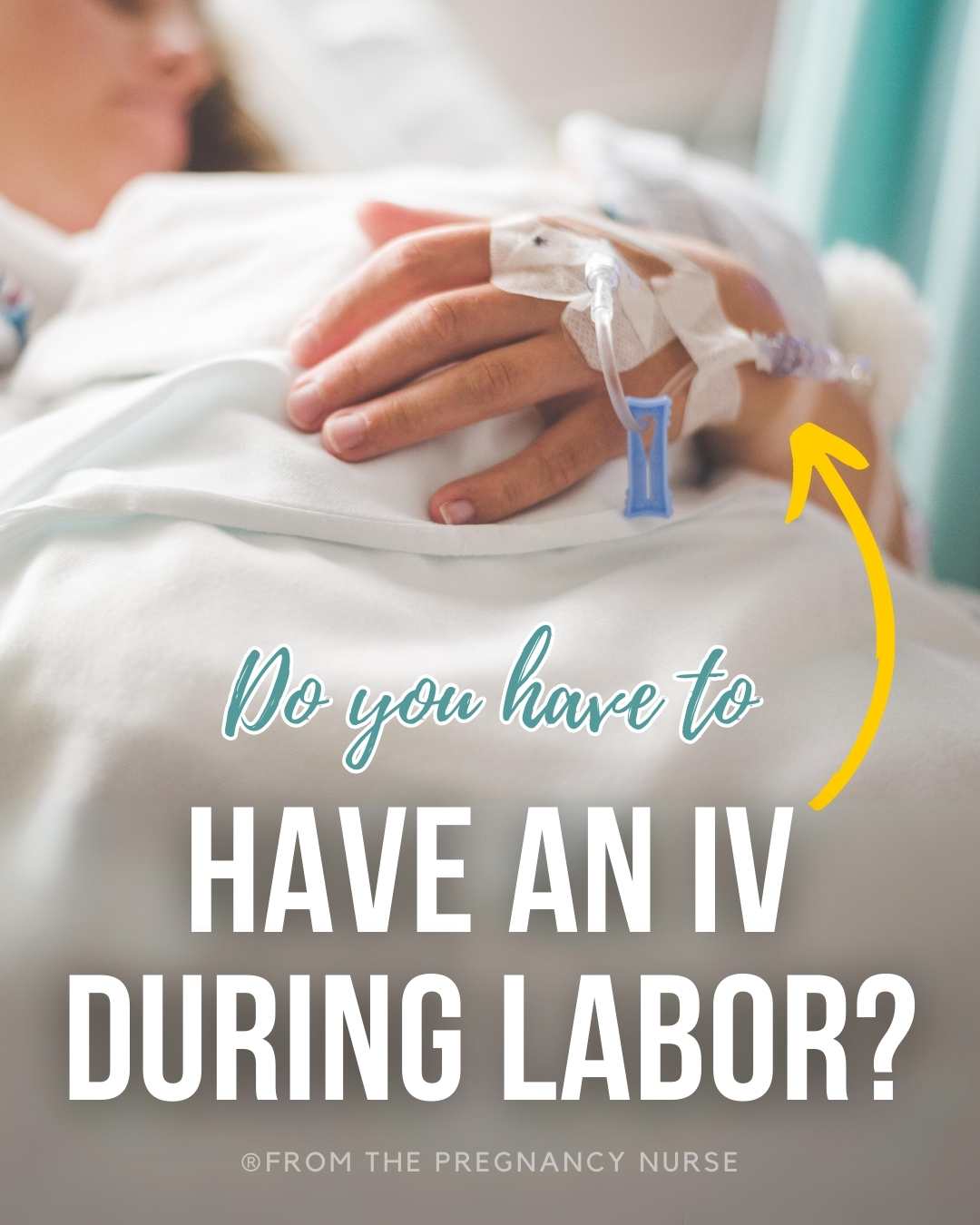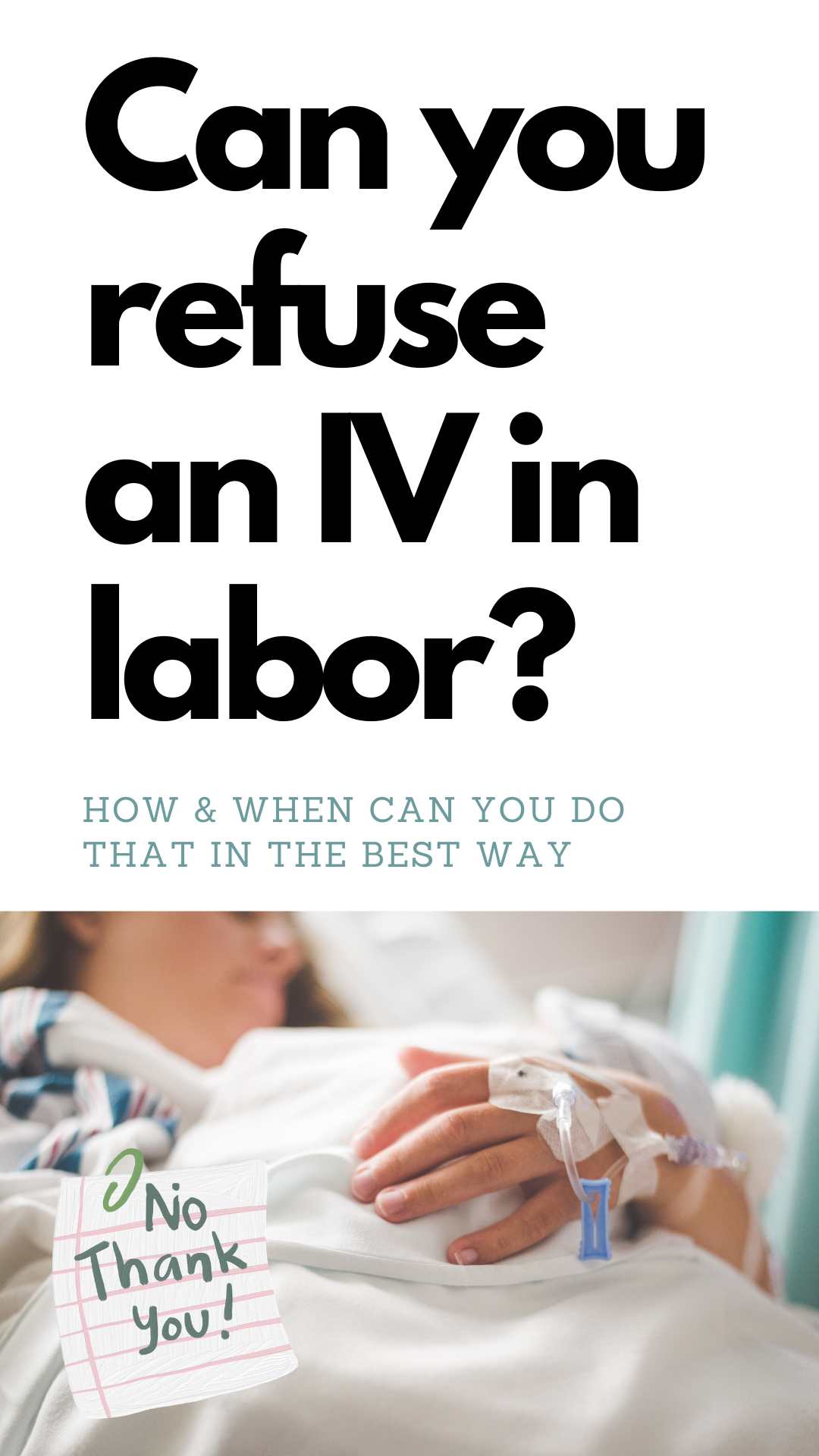You’re thinking you likely won’t need an IV during labor and you hate needles. So, can you refuse an IV during labor, how do you do it and what are some things to consider (or alternatives) as you make this big choice?
Ok, let’s get this out of the way….
Can you refuse an IV during labor (or while at the hospital)?
Absolutely. You can refuse any treatment while you’re at the hospital. That being said — when we have things that we “usually” do there is often a reason behind it so it’s really important to consider that.
A lot of people like the “safety” of the hospital but don’t want anything that we use to create that safety. Things like IV, monitoring baby and other things help us create that cocoon of safety to watch to see if anything is going wrong. Things like this are what make hospitals safer.
Just know that YOU are always in the driver’s seat and making the choices along the way. Even if you get the IV and then you want it removed you can ask them to do so. Your nurse may be very resistant (as it would be their job to put it back in should you need it) but they should still do it.
Sometimes nurses will brush-off your request, but doing something like “please chart that I am no longer wanting the IV and please remove it” helps them to know you’re serious about it. FYI.
Before we keep going, if you’re thinking about all of this — grab my birth plan helper:
Reasons we recommend an IV during labor:
The biggest reason is if you need medications or blood products pumped into your veins. Emergencies can happen at any time while you are both in labor and after the baby is born.
The biggest reason is possibly a hemorrhage, where you start to bleed out. Because your uterus gets SO much blood flow to grow a baby, as you can imagine it can also leak out a lot of blood. In fact, probably more blood than anywhere in the hospital. It is imperative that we act quickly, and if we have to place a line that adds to the time we are able to act and provide life-saving means for you.
I see a lot of people saying “we can just place an IV if we need it” but if your body NEEDS that IV (say, in the case of a hemorrhage) your veins tend to get really small and it is VERY difficult to get the IV in. Not to mention the pressure of you possibly dying if we don’t get it in fast — it’s just not a situation we want to be in.
Hey, if you’re loving this look into the hospital I’d totally recommend getting prepared with this.
So, all of that would be in cases where you didn’t actually need an IV in labor — but there are some actual reasons you’d NEED an IV:
Reasons You’ll Need an IV in Labor
Induction: If you’re being induced you will need an IV in place. Being induced increases chances of something going wrong, and having an IV is really important.
And yes, if you choose to decline the IV you are basically also declining the induction. While some methods of induction aren’t given IV, even the ones placed other ways we need that IV in, in case something goes wrong. As a nurse I can’t give specific meds without having an IV in place or I could lose my lisence.
AND if you’re getting Pitocin for your induction we need the IV to infuse that medication for you.
Cesarean Section: Hopefully it makes sense to you that if you’re having surgery (where you’ll need medications to help you not feel it) you will need an IV.
IV Meds (including pain meds): This one makes sense. If you want pain medicine through an IV, you’ll need an IV placed. There are other times we run meds through your IV like Magnesium if your have preeclampsia.
Some facilities do have Nitrous Oxide, and their policy may vary as to if you need an IV to get that, so ask your provider if they know about that.
An Epidural: You absolutely have to have an IV to get an epidural. We need to give you some extra fluids before the epidural is placed, and we may need to give other medications to increase your blood pressure should it fall after the epidural (not uncommon).
Wondering more about pain management options — join me in here where I have a whole lesson where I go through all of them and the pro’s con’s to each of them (plus a whole natural pain management bonus video too).
Antibiotics: In labor and delivery almost all antibiotics are given through your IV (this includes antibiotics for GBS). You could refuse the antibiotics, but make sure you understand that choice thoroughly as well.
But here’s a little-known secret that I think you might enjoy:
If I don’t need the IV right now, is there an alternative?
YES! It’s called a saline lock. We place it just like an IV (and we’ll probably run a little bit of fluid through it to make sure it “works”) and then a little piece of plastic tubing will be taped to your arm, but you will NOT need to be hooked-up to the IV, you’ll just have the lock in your arm.
And, even if it’s bugging you I sometimes use a little bit of stocking (it’s not actually a sock — but you can ask your nurse for this) to cover it up so it’s not snagging on things, and you don’t have to see it.
This is a GREAT alternative — as the IV is there should we need it, but doesn’t seem as “medical-y” and it doesn’t tie you down. I’m a huge fan of the saline lock (they used to be called heplocks, but we don’t use heparin in them anymore — hence, saline Lock).
How to refuse an IV in labor?
Ok, you’ve read this far, but you still really don’t want an IV in labor. What do you do?
Talk with your provider about it early on. It is WAY easier for them to have these conversations with you at prenatal appointments where things are calm and you can take the information they give and mull it over at home on your own time too. They will need to go over the risks to not having an IV and also remind you that the saline lock is a great alternative.
Your provider can note it in your chart and he can let the providers at the hospital know that he’s reviewed it with you and this is your wishes after a very good informed consent. It will just make it a LOT easier on everyone (including you)!
Just showing up to the hospital and then telling your providers you don’t want an IV makes it REALLY hard for us. That puts us in the seat of needing to give you that valuable informed consent at the time that we also need to be admitted you and doing 400 other things. So, talking about it early is SO smart (I love that you’re here reading about this).
Where do they usually put the labor IV?
I get asked this a LOT so I thought I’d address it in here.
We try to get it somewhere in your forearm.
We really want to get a spot that is:
- Not super annoying to you (hand iv’s often aren’t my favorite)
- Will kink off when you’re pushing (meaning your elbow is normally out)
- Won’t get in the way of breastfeeding (so we try not to do your direct forearm where baby may rest their heads)
I always tried for non-dominant forearm first. BUT I also want to encourage you that the BEST place to get your IV is a spot where your nurse is confident they can get it in.
I inspect both arms for quite a bit before picking my spot, and good nurses should do that. SO if they’re taking their time don’t worry that they’re not going to be good at it — good nurses inspect ALL their options.
And, if you love a good nurse by your side — let me join you for the rest of your pregnancy:
What risks am I assuming if I don’t have an IV or a saline lock in place?
You’re assuming the risk that they might not be able to get an IV in should you emergently need it and that will leave them unable to run fluids, and provide IV meds as quickly (or, at all).
Yes, they can place I/O access (it’s drilled into your bone) once the rapid response team gets there, but it still wastes time and you can’t run blood via i/o.
And this is the root of why your medical team is so hesitant to let you blithely refuse it. It’s really important that you understand it could be your lifeline to help — and we can’t promise that we are able to get one in during an emergency.
Understanding informed consent is something we talk about constantly in here. Helping you talk with your providers more about what choice is best for you.
When will they take my IV out?
Like I said above you can have your IV removed at any time, but most hospitals have a policy that they will remove the IV after X amount of time. Often if it is your second+ baby they may leave it in a bit longer as your chance of a hemorrhage is greater.
They may also encourage you to leave it in a bit longer if you have a history of bleeding, any issues bleeding during labor, etc.
ALSO, if you have IV antibiotics ordered after delivery they will need the IV in place to give those (but they can turn it into a Saline Lock when they’re not using it).
So, if you want it out — talk with your doctor/midwife or nurse about why you still need it in and if it’s OK to take it out.
And like I said, it’s fine to — at any time — say “I want this out.“ Just remember you’re assuming the risks, and there may be things they can’t do without an IV in.
You can also ask if you can have it un-hooked from the IV line so it’s a saline lock instead of a running IV — this can’t always be done (like, during a C-section) — but often it can. Or, if you hate the placement you can ask them to put a new one in different spot (which may not always be possible).
But mostly I want to tell you that I love that you’re thinking about this in advance. It gives you more time to learn more about it and think about times you would or would not prefer it. Learning more about interventions in labor is so smart, so good job on doing that.
If you want to learn more about the interventions in labor and delivery, I recommend taking a prenatal class from someone who knows them (like a nurse) — come join The Online Prenatal Class for Couples where we lean into sharing what types of things to expect at the hospital and how you can use them or not use them (and how to talk with your team about it).
Want to do a vibe check before diving into the whole thing with me? — check out my free labor pro tips. It’s your first step toward getting in the driver’s seat of your birth.








 Should You Buy Your Own Fetal Doppler?
Should You Buy Your Own Fetal Doppler?
